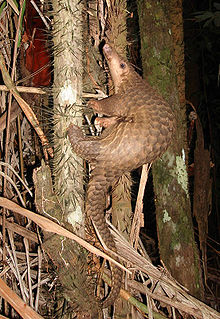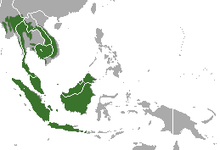- Sunda Pangolin
-
Sunda Pangolin[1] 
Conservation status Scientific classification Kingdom: Animalia Phylum: Chordata Class: Mammalia Order: Pholidota Family: Manidae Genus: Manis Species: M. javanica Binomial name Manis javanica
Desmarest, 1822
Sunda Pangolin range The Sunda Pangolin (Manis javanica), also known as the Malayan Pangolin or Javan Pangolin, is a species of pangolin.[1] It is found in South-East Asia, including Thailand, Indonesia (Java, Sumatra, Borneo and the Lesser Sunda Islands), the Philippines, Vietnam, Laos and Cambodia, and Malaysia and Singapore.[2] These pangolins are found in Southeast Asia’s forested habitats (primarily, secondary, scrub forest) and plantations (rubber, palm oil). Mostly, they spend time within tree resting or searching food.
The skin of its feet is granular although there are pads on its front feet. Its tail has 30 scales.
In the past this species has included the closely related Palawan Pangolin (Manis culionensis) as both are in the subgenus Paramanis.[3] It is closely related to the Chinese Pangolin, although the Malayan species is larger, lighter in colour and has shorter foreclaws.
The Sunda Pangolin's main predators are the tiger and the Clouded Leopard.
It has thick and powerful claws to dig into the soils in search of ant nests or to tear into termite mounds. The nose is fleshy and possess a strong sense of smell. It has no teeth. Instead, it has a long and sticky tongue that helps it collect ants and termites. Its body is covered by rows of scales and fibrous hair. Head-body length of pangolin is up to 65 cm, tail length is up to 56 cm and its weight is up to 10 kg. Males are larger than females.
Pangolins give birth annually to one or two offsprings. It breeds in the autumn and gives birth in the winter burrow. Parental care will be given for approximately three months. Pangolin sometimes found in pairs, but normally solitary, noctural and behaves timid. It protects its soft underparts by rolling into a ball when they feeling threatened. They are strong diggers and will make burrows lined with vegetation for insulation near termite mounds and ant nests.
Advantages of these animals are constructing burrow to get ants and termites for food resources. Besides that, it also helps in soil aeration. Human beings hunt the pangolin for their skins, scales and meat. Their parts are used for medicinal purposes. Scales of pangolin are made into a ring as a charm against rheumatic fever and meat is eaten by indigenous peoples. Besides that, skins are also used to make shoes. One of the main importers of pangolin skins from 1980–1985 was the United States of America.
References
- ^ a b Schlitter, Duane A. (16 November 2005). "Order Pholidota (pp. 530-531)". In Wilson, Don E., and Reeder, DeeAnn M., eds. Mammal Species of the World: A Taxonomic and Geographic Reference (3rd ed.). Baltimore: Johns Hopkins University Press, 2 vols. (2142 pp.). p. 530. ISBN 978-0-8018-8221-0. OCLC 62265494. http://www.bucknell.edu/msw3/browse.asp?id=13900012.
- ^ a b Pangolin Specialist Group (1996). Manis javanica. 2006. IUCN Red List of Threatened Species. IUCN 2006. www.iucnredlist.org. Retrieved on 11 May 2006.
- ^ Schlitter, Duane A. (16 November 2005). "Subgenus Paramanis". In Wilson, Don E., and Reeder, DeeAnn M., eds. Mammal Species of the World: A Taxonomic and Geographic Reference (3rd ed.). Baltimore: Johns Hopkins University Press, 2 vols. (2142 pp.). p. 530. ISBN 978-0-8018-8221-0. OCLC 62265494. http://www.bucknell.edu/msw3/browse.asp?id=13900005.
External links
- Sunda Pangolin at Ecology Asia [1]
- Sunda Pangolin at Animal Diversity Web
- WWF & TRAFFIC Report: Pangolin trade in Sabah (PDF)
- WWF News: Seized notebooks give unique insight into scale of illicit pangolin trade
Extant Pholidota (Pangolins) species Kingdom: Animalia · Phylum: Chordata · Class: Mammalia · Infraclass: Eutheria · Superorder: Laurasiatheria Manis Subgenus Manis: Indian Pangolin (M. crassicaudata) · Chinese Pangolin (M. pentadactyla)
Subgenus Paramanis: Philippine Pangolin (M. culionensis) · Sunda Pangolin (M. javanica)
Subgenus Smutsia: Giant Pangolin (M. gigantea) · Ground Pangolin (M. temmincki)
Subgenus Phataginus: Tree Pangolin (M. tricuspis)
Subgenus Uromanis: Long-tailed Pangolin (M. tetradactyla)Category Categories:- IUCN Red List endangered species
- Pangolins
- Myrmecophagous mammals
- Mammals of Brunei
- Mammals of Cambodia
- Mammals of China
- Mammals of Indonesia
- Mammals of Laos
- Mammals of Malaysia
- Mammals of Burma
- Mammals of Thailand
- Mammals of Vietnam
- Fauna of Borneo
Wikimedia Foundation. 2010.

